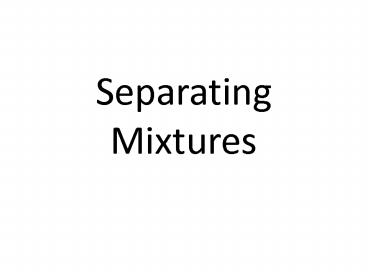Separating Mixtures PowerPoint PPT Presentation
Title: Separating Mixtures
1
Separating Mixtures
2
What is a mixture?
- When two or more materials or substances are
mixed together but do not chemically combine. - This means they retain their original properties.
- This means they can be separated by physical
means.
3
What are the different ways of separating
mixtures?
- Magnetism
- Hand separation
- Filtration
- Sifting or sieving
- Extraction and evaporation
- Chromatography
4
Magnetism
- If one component of the mixture has magnetic
properties, you could use a magnet to separate
the mixture. Iron, nickel, and cobalt are all
materials that are magnetic. - Not all metals are magnetic gold, silver, and
aluminum are examples of metals that are not
magnetic.
5
Example of magnetism
- Using a magnet to separate nails from wood chips.
6
Hand separation
- Separating the parts of a mixture by hand.
- Only useful when the particles are large enough
to be seen clearly. - Useful for separating parts of a salad.
7
Example of hand separation
- Using your fork to separate tomatoes, lettuce,
cucumber, onions, etc. in your salad.
8
Filtration
- Used when separating a solid substance from a
fluid (a liquid or a gas) by passing a mixture
through a porous material such as a type of
filter. - Works by letting the fluid pass through but not
the solid. - Examples of filters coffee filter, cloth, oil
filter, even sand!
9
Example of filtration
- Using a coffee filter to separate the coffee
flavor from the coffee beans.
10
Sifting or sieving
- Used to separate a dry mixture which contains
substances of different sizes by passing it
through a sieve, a device containing tiny holes.
11
Example of sifting/sieving
- Using a sieve to separate sand from pebbles.
12
Extraction
- Used to separate an insoluble solid (something
that doesnt dissolve in a liquid) from a soluble
solid (something that DOES dissolve in a liquid).
Done by adding a solvent (liquid that does the
dissolving) to the mixture. Then pouring the
liquid through a filter.
13
Example of extraction
- With a mixture of sugar and sand, pouring water
in the mixture which causes the sugar to
dissolve. Then pouring the solution through a
filter, causing the sand to separate from the
sugar water.
14
Evaporation
- Allowing the liquid to evaporate, leaving the
soluble solid behind. - Example heating sugar water. The water
evaporates and the sugar crystals are left
behind.
15
Example of using extraction and evaporation
together
- Using water to dissolve sugar, then letting the
water evaporate, leaving the sugar behind.
16
Chromatography
- Used to separate dissolved substances in a
solution from each other.
17
Example of chromatography
- Using chromatography paper to separate ink into
its original components.

